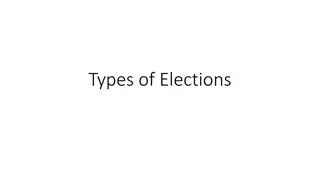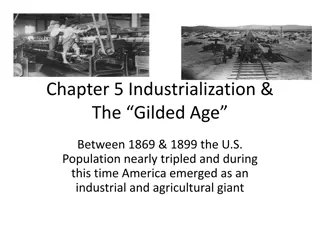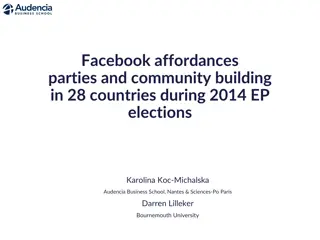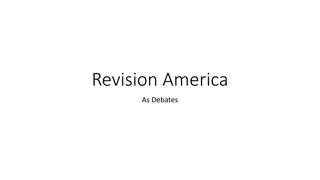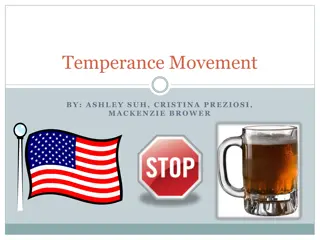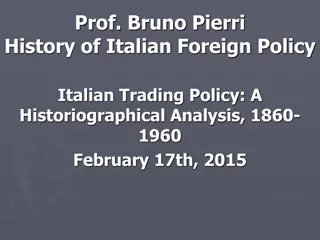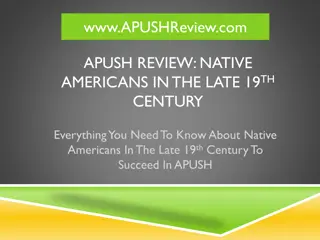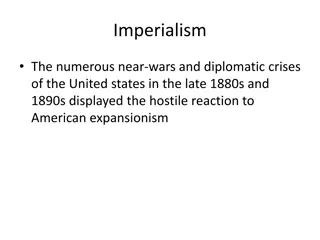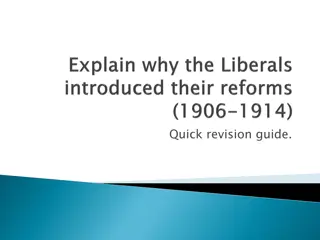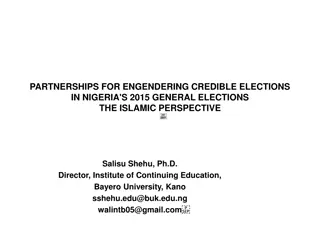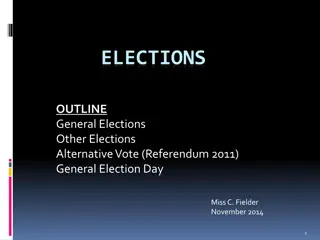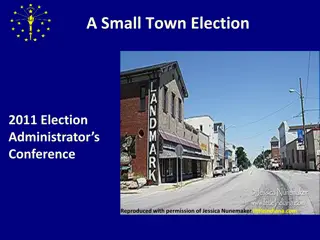Political Landscape and Elections in the Late 19th Century
The political scene in the late 19th century in the United States was marked by the rise of the Second Party System, leading up to the pivotal Presidential Election of 1896. The Congressional elections of the era reflected shifts in power between Democrats, Republicans, and various opposition groups. Additionally, the Presidential elections from 1864 to 1896 showcased intense competition and notable candidates like Lincoln, Grant, Cleveland, and McKinley. Bryan's famous "Cross of Gold" speech also left a lasting impact on the era's political discourse.
Download Presentation

Please find below an Image/Link to download the presentation.
The content on the website is provided AS IS for your information and personal use only. It may not be sold, licensed, or shared on other websites without obtaining consent from the author. Download presentation by click this link. If you encounter any issues during the download, it is possible that the publisher has removed the file from their server.
E N D
Presentation Transcript
The Second Political Party System: 1856 - 1896 The Presidential Election of 1896
Congressional Elections: 1854 - 1896 HOUSE SENATE Democrat Opposition Democrat Opposition Republican Republican 1854 83 100 (51A) 39 22 (1A) 1856 132 90 (14A,1) 41 20 (5A) 1858 83 116 (5A,36) 38 26 (2A,2) ----------------------------------------------------------------------- Democrat Republican Unionist Democrat Republican Unionist 1860 44 108 30 (1I) 15 31 3 1862 72 85 25 (2IR) 10 33 5 1864 38 136 18 (1IR) 11 39 4 ----------------------------------------------------------------------- 1866 47 173 (6) 9 57 (2 Vacant) 1868 67 171 24 (5C) 12 62 1870 104 136 (3IR) 17 57 1872 88 199 (4LR,1ID) 19 54 (1 Vacant) 1874 183 106 (1I) 28 47 (1 Vacant) 1876 157 136 35 40 (1I) ----------------------------------------------------------------------- 1878 148 132 (13NL) 42 33 (1I) 1880 129 151 (10NL,2J,1I) 37 37 (1I,1J) 1882 199 118 (4J,2I,2NL) 36 38 (2J) 1884 183 141 (1NL) 34 42 1886 167 154 (2L,1NL,1I) 37 39 1888 152 179 (1L) 37 51 1890 238 86 (8P) 39 47 (2P) 1892 220 124 (11P,2S) 44 40 (3P,1S) 1894 93 254 (9P,1S) 40 44 (4P,2S) 1896 124 207 (22P,1S,3SR) 34 44 (5P,2S,5SR) ----------------------------------------------------------------------
Presidential Elections: 1864 - 1896 Democrat Republican --------------------------------------------------------------------------- 1864 McClellan 21 1,836,072 44.91 Lincoln 212 2,220,846 55.08* 1868 Seymour 80 2,708,744 47.29 Grant 214 3,013,650 52.70* 1872 Greeley --- 2,835,315 43.82 Grant 286 3,598,468 55.63* 1876 Tilden 184 4,288,191 51.01* Hayes 185 4,033,497 47.87 1880 Hancock 155 4,445,526 48.21 Garfield 214 4,453,611 48.31 1884 Cleveland 219 4,915,586 48.49 Blaine 182 4,852,916 48.26 1888 Cleveland 168 5,539,118 48.68 Harrison 233 5,449,825 47.79 1892 Cleveland 277 5,554,617 46.07 Harrison 145 5,186,793 42.92 1896 Bryan 176 6,370,897 46.70 McKinley 271 7,105,144 51.02* ---------------------------------------------------------------------------
Having behind us the producing masses of this nation and the world, supported by the commercial interests, the laboring interests, and the toilers everywhere, we will answer their demand for a gold standard by saying to them: "You shall not press down upon the brow of labor this crown of thorns; you shall not crucify mankind upon a cross of gold."
Summary -- Realignment of the 1890s -- Neither Party Replaced 1. Breadth and Depth of the Underlying Grievance Not too great. The Farmers and the Labor Unions were angry but the Bi-Metalism Issue did not have the power that Slavery had and Inflation after 1895 negated the issue. 2. Capacity to Provoke Resistance Farmers had many successes. 3. Leadership Held firm in the Republican Party but the Democratic Party was split internally. 4. Division of Polar Forces Between the Two Parties Affected Mainly the Democrats.
5. Strength of Existing Party Attachments Strong, especially for Republicans. The Silver Republicans stayed in the Party while the Gold Democrats switched to the Republican Party.
SUMMARY Realignment of the 1890s -- The Realignment Scenario Clearly Type 2 -- Realignment in which Neither Party is Replaced. The System evolves from State A to State B/C and snaps back into State A.





